El Cucuy: The Shadow of Fear in Medieval Spain
Reading Time: 12 min
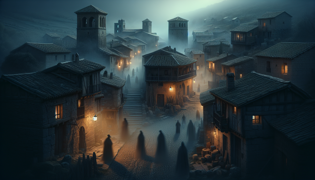
About Story: El Cucuy: The Shadow of Fear in Medieval Spain is a Folktale from spain set in the Medieval. This Descriptive tale explores themes of Good vs. Evil and is suitable for All Ages. It offers Cultural insights. A chilling tale of a mysterious figure haunting the nights and teaching lessons to the disobedient.
Introduction
In the shadow of the Pyrenees, a medieval Spanish village huddled beneath the ominous gaze of ancient stone towers and mist-shrouded hills. As twilight bled into the night, a palpable fear swept through the narrow cobbled streets. Parents hushed their children with whispered warnings of the elusive entity known as El Cucuy. The legends told of a dark figure lurking in the gloom, a spectral reminder of transgressions and misbehavior, waiting to snatch away wayward souls. In this village, where every crumbling wall held stories of valor and loss, the boogeyman’s myth was as real as the chill that crept beneath doorways. Families spoke in hushed tones of his shadowed form and the echo of his footsteps that resonated in the quiet alleys. With each sunset, caution grew, and the nights turned into a canvas of fear and whispered hope. This tale begins at the crossroads of childhood innocence and the stark reality of consequences, where an unforgiving darkness prowls at the margins of every memory and dream. Amidst the ancient oaks and worn stone paths, young hearts learned quickly that true terror sometimes came to those who strayed from the righteous path, for El Cucuy was never just a fable, but a living specter of punishment and regret.
Shadows in the Alleyways
As night fell upon San Martino, the ancient village stirred with the hush of trepidation. In the winding alleyways, children clutched their toys and whispered age-old secrets about the dreaded El Cucuy. At the heart of these tales was the troubled life of young Diego, an orphan with rebellious eyes and a heart that throbbed with both defiance and despair. Rumors declared that Diego’s rowdy behavior had once attracted the dark attention of the spectral enforcer. His footsteps on the timeworn cobblestones resonated with memories of maternal reprimands and cryptic admonitions from elderly neighbors. Every corner of San Martino seemed to murmur warnings: stray from the path, and the shadow will claim you.
Diego roamed the backstreets, the flickering glow of scattered lanterns highlighting a face that masked more than it revealed. Though his eyes showed sparks of resilience, his soul carried scars of past misdeeds and the heavy burden of community expectations. In hushed gatherings, Señora Marisol, a venerable storyteller with a voice both tender and commanding, recited the legend of El Cucuy. She described a spectral figure with tangled hair, hollow eyes, and a hunch that whispered of inevitable doom. His presence was a reminder that misbehavior came with a penance—a dire caution that the darkness itself kept a meticulous ledger of every sin.
On a particularly cold evening, as a dense fog enveloped the village, Diego encountered a mysterious cloaked figure in a deserted lane. The stranger’s words, soft yet laden with dread, cut through the silence: ‘Beware, child; the night is alive with those who wander lost in sin.’ Those words, like seeds of panic, took root in Diego’s heart. Suddenly, each creak of old wood, every scraping of gravel underfoot, transformed into a sinister echo of his past. The villagers, now gripped by a renewed horror, shuttered their homes and prayed to banish the lurking presence.
In a whirlwind of uneasy nights and uncertain days, Diego’s internal battle began to mirror the physical dread that haunted the village. His dreams turned dismal; corridors of crumbling stone, etched with stains of past transgressions, visited him in sleep. Through these specters of memory, Diego recognized his misdeeds, the rebellious defiance now morphing into a willingness to accept accountability. As the eerie whispers of the past intermingled with the tangible terror of El Cucuy, the village’s narrative gained depth—a grim tapestry that wove personal sorrow with communal lore.
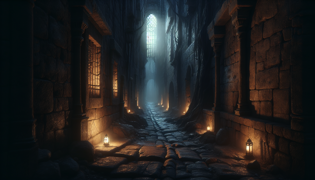
Echoes of the Past
In the cool aftermath of unsettling encounters, Diego’s life grew inseparable from the village’s collective memory. The elders often recalled how every brick and stone of San Martino resonated with the sorrow and wisdom of generations long gone. Far from being a mere tool to discipline miscreants, the legend of El Cucuy had evolved into an echo of ancient customs—a ritual intended to remind the young of the grave responsibilities of freedom.
Each gathering in the central plaza became a solemn affair at dusk. The soft strum of a guitar and the rhythmic tap of castanets, once emblematic of joyous celebrations, now mingled with a sense of mourning and cautious introspection. The plaza, dominated by timeworn arches and crumbling facades, transformed under the weight of remembered sins and the promise of redemption.
Drawn by the lure of forgotten histories, Diego ventured to an abandoned chapel on the village outskirts. Its faded murals depicted the eternal struggle between saints and sinners, light and darkness. Here, he met Father Rodrigo, a weathered priest whose gentle, sorrowful eyes held both the scars of loss and the spark of hope. In muted tones, Father Rodrigo explained that El Cucuy had once been invoked during the darkest periods of plague and despair—a spectral guardian meant to steer society back to virtue. "In every era," the priest insisted softly, "the frightful visage of El Cucuy emerged not solely to punish, but to remind us of the moral paths that must never be forsaken."
Compelled by Father Rodrigo’s wisdom, Diego began to study ancient texts and weathered manuscripts preserved within the chapel’s crumbling vaults. Each delicate page revealed more about the origins of the legend: how the embodiment of fear was woven from the communal need for order, and how the supernatural was often a mirror to the collective conscience. With every revelation, Diego found himself torn between disbelief and a desperate yearning for understanding. Was El Cucuy an actual spectral predator, or merely a manifestation of the darker corners of human nature?
Within those venerable walls, amid the interplay of shifting shadows and fractured stained glass, Diego recognized a deeper truth. The spectral figure was a complex symbol—a blend of punishment and protection, warning and wisdom. In absorbing these ancient lessons, he began to see his own struggles as part of a larger, timeless war between light and shadow. His heart, once embittered by defiance, now stirred with the faint promise of redemption. The echoes of the past beckoned him to reconcile his own darkness with the shared, painful history of his people.
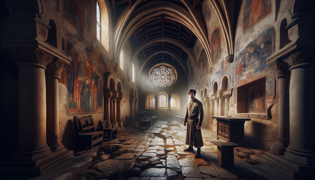
A Haunting Decision
Troubled by revelations of bitter history and tormented by his own misdeeds, Diego approached a critical juncture in his journey of self-forgiveness. As autumn’s chill swept over the village and the annual festival began its somber rituals, the collective celebration took on a double edge—joy tempered by remembrance and fear. The townsfolk gathered to honor their ancestors with candlelit vigils and bittersweet music, yet an undercurrent of apprehension ran through the air. The exuberance of celebration was haunted by whispers of the dreaded visitor who, once a year, emerged to mete out retribution.
On that fateful night, as families encircled a towering bonfire in the central square, the sky grew dark and heavy with unspoken portents. The flickering firelight painted trembling figures on the walls of ancient stone, and amidst the chorus of quiet prayers and hushed conversations, Diego found himself withdrawn. The festivities, intended as both a tribute and a catharsis, only reinforced the internal conflict raging within him. His mind swirled with the dread of retribution and the stark realization that his path to atonement might be intertwined with the very legend he so feared.
It was then that a cloaked silhouette, indistinct and chilling, appeared at the edges of the bonfire’s glow. Rumors had long asserted that this spectral visitor was the very incarnation of El Cucuy—a haunting arbiter who judged those straying from virtue. The figure moved with a ghostly elegance, its tattered robes merging with the night as softly as if in mourning. In that charged moment, time halted; the roar of the bonfire and the murmurs of the crowd faded into silence, leaving only the beating of Diego’s heart.
Grappling with an overwhelming mix of terror and resolve, Diego felt the truth stirring within him. Here lay not just the punishment for disobedience, but the embodiment of his internal battle between sin and redemption. With a trembling yet steadfast determination, he stepped away from the safety of the crowd, following the spectral figure as it led him deeper into the labyrinthine maze of ancient, deserted streets. The chilling night and the flicker of distant candlelight bore witness to a solitary decision—one that would seal his fate and perhaps alter the destiny of the village.
In stepping into the embrace of the mysterious apparition, Diego recognized that the harrowing journey was no longer merely about confronting a mythical monster, but about facing the inner darkness that resided in every human heart. With each hesitant step, the demarcation between myth and reality blurred, and the decision to seek forgiveness became both a personal battle and a symbolic challenge to the legacy of fear that gripped San Martino.
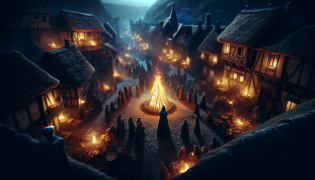
Confrontation in the Dark
As the night deepened towards the inevitable break of dawn, Diego’s inner torment reached its zenith. On the fringes of a desolate part of the village, where withered trees and crumbling trellises bore silent witness to the passing centuries, he faced the unavoidable: his long-feared destiny. There, under a shuddering sky and a weak crescent of moonlight, the spectral form of El Cucuy emerged in all its horrifying glory.
The creature was an ever-changing silhouette—a mass of shifting darkness with eyes like glowing embers, its features ambiguous yet terrifyingly familiar. Every step it took seemed to echo the lamentations of lost souls. Diego’s heart pounded violently as the spectral presence advanced deliberately, the chill in the air deepening with each measured step. In that seething silence, the young man’s inner weaknesses were cast in the starkest relief. The ghostly figure, drawn from the collective fears of an entire community, now appeared as an embodiment of every sin and every sorrow Diego had ever owned.
In a voice that quavered between defiance and despair, Diego broke the silence: 'I am not nothing but a sinner in need of redemption. I refuse to be defined solely by my mistakes.' His words, fragile yet resolute, hung in the air like a challenge to the ancient specter. For a suspended moment, the oppressive darkness seemed to pause, and in that pause lay the glimmer of transformation. The ghostly figure’s eyes, which had burned with the harsh light of judgment, softened—a silent acknowledgment of the courage it took to face one’s own reflection in the abyss of sin.
Then, as if weighed down by centuries of sorrow, the entity receded into the night, leaving Diego trembling beneath its vast implication. The confrontation, both horrifying and cathartic, marked the turning point of his journey. Diego realized that El Cucuy was not an external executioner but a mirror reflecting the inescapable inner darkness present in every soul. The terror he had once felt was now replaced by a profound understanding that redemption could be pursued through acknowledging and overcoming one’s mistakes.
In the ensuing hours before the break of dawn, as the village slept fitfully, Diego retraced his steps along the labyrinthine alleys. His spirit felt both scarred and emboldened—a duality that resonated with the essence of San Martino itself. The night had stripped him bare of pretenses, leaving only the heart’s raw, honest beat as the measure of true courage. With the faint blue blush of early morning on the horizon, he emerged not as a broken child haunted by a myth, but as a young man awakened to the possibility of change and armed with the resolve to transform his fate.
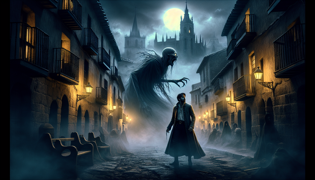
Conclusion
As the first light of a new day broke softly over San Martino, the consequences of a long, soul-stirring night became evident. Diego’s journey, which had plunged him into the depths of fear and self-confrontation, had culminated in a transformation that resonated deeply with the hearts of the villagers. The age-old terror of El Cucuy now carried a dual message. It was still the specter that enforced discipline and feared disobedience, but it had also become a symbol of the possibility of change—a mirror revealing that redemption lay within the acknowledgment of one’s own failings.
In the communal hush of dawn, the people gathered in quiet reflection. Conversations shifted from trembling warnings of the boogeyman to a more nuanced discussion about the force of inner darkness and the strength required to overcome it. Families who had once shuddered at the mere mention of El Cucuy now found solace in the notion that the very legend which instilled them with fear could also inspire transformation and integrity. In the soft light, old grievances began to yield to new understanding. The myth, once solely a deterrent for misbehavior, evolved into an emblem of both the harsh consequences of unchecked impulsivity and the redemptive power of self-realization.
Diego emerged as an unlikely hero—a living testament that even a tortured soul, battered by the ruthless tide of personal failures, could carve a path toward moral restoration. His courageous confrontation with the supernatural became a clarion call for not only self-forgiveness but also for communal empathy. His journey encouraged others to peer into the shadows of their own lives, to reconcile with their demons, and to nurture hope amid despair.
In the days that followed, the legend of El Cucuy was recounted with renewed wisdom. Artists, poets, and elders began to weave its narrative into the broader cultural fabric of San Martino, portraying the boogeyman not solely as a figure of punitive dread but as a symbol of the eternal struggle between human frailty and the resilience of the spirit. Though the specter might one day return, the people now understood that the true terror lay not in the whispers of an ancient tale, but in the refusal to confront and overcome one’s internal darkness. The dawn had not only banished the night; it had ushered in the possibility of rebirth, where even the darkest legends could yield to the light of redemption.
















